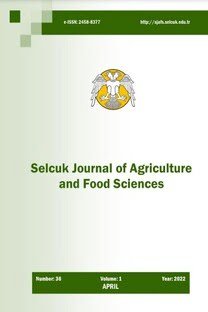Türkiye' de yabani olarak yetişen bazı sumak (Rhus coriaria L.) meyvelerinin fiziksel ve kimyasal özelliklerinin belirlenmesi
Türkiye'nin farklı, lokasyonlarından (Çanakkale, Hakkari, Hatay, İskenderun, Kastamonu, Manisa, Kahramanmaraş, Mut, Siirt ve Silifke) toplanan sumakların meyve ve çekirdeklerinin en, boy ve kalınlık özellikleri, perikarp ve çekirdeklerin rutubet, kül, %10 HCl'de çözünmeyen kül, protein, yağ ve ham selüloz içerikleri incelenmiştir-. Boyut ve ağırlık değerleri bakımından Hakkari örnekleri diğerlerine göre daha yüksek bulunmuştur. Örneklerin perikarplannda yapılan kimyasal analiz sonuçlarına göre, protein, yağ, ham selüloz, kül ve %10 HCl'de çözünmeyen kül içerikleri sırasıyla, %4.70-8.1, %13.77-37.5, %19.21-24.40, %0.94-2.21 ve %0.13-1.24 aralıklarında iken, bu sıralama çekirdeklerde, %8.15-10.39, %9.17-18.66, %28.83-36.25, %1.09-2.01 ve %0.07-0.17'dir.
Anahtar Kelimeler:
Anacardiaceae, Kahramanmaraş, Kastamonu, Rhus coriaria, kimyasal özellikler, fiziksel özellikler, Çanakkale, Hatay, Siirt
Determination of phiysical and chemical properties of some sumach (Rhus coriaria L.) fruits growing wild in Turkey
The width, length and thickness of the fruits and the seeds and the humidity, ash content, unsoluble ash in 10% HCl, protein content, oil content and crude fiber content of the pericarb and seeds of sumach samples, collected from different locations (Çanakkale, Hakkari, Hatay, İskenderun, Kastamonu, Manisa, Kahramanmaraş, Mut, Siirt and Silifke) were de¬termined. Dimension and weight values of Hakkari samples were higher than those of the others. While, the protein content, oil content, crude fiber content, ash content and the unsoluble ash in 10% HCl of the pericarbs range between, 4.70%-8.1%, 13.77%-37.5%, 19.21%-24.40%, 0.94%-2.21% and 0.13%-1.24%, seeds were established between 8.15%-10.39%, 9.17%-18.66%, 28.83%-36.25%, 1.09%-2.01% and 0.07%-0.17%, respectively.
Keywords:
Anacardiaceae, Kahramanmaras, Kastamonu, Rhus coriaria, chemical properties, physical properties, Canakkale, Hatay, Siirt,
___
- 1. Akgül, A., 1993. Baharat Bilimi ve Teknolojisi. Gıda Tek¬nolojisi Demeği Yay. "No: 15, Ankara.
- 2. Al-Shabibi, M.M.A., Siddiqi, A.M., Kassim, S., Haddad, B'.A., 1982. Studies on the sumach of Iraq. I. proximate analysis, and characterization of seed coat lipids. Can. hfst. Food Sci. Techiil. J. 15:65-67.
- 3. Aganga, A.A., Mosase, K,W. 2001. Tannin content, nutritive value and dry matter digestibility of Lonchocarpus capjassa, Zizyphus mucronata, Sclerocaiya birrea, Kirkia acuminata and Rhus lancea seeds. Anim. Feed Set Tech. 91:107-113.
- 4. Anonymous, 1983. Sumak (Somak) Öğütülmüş, TS 3880. Türk Standardları Enstitüsü. Ankara.
- 5. Anonymous, 2000. Türk Gıda Kodeksi, Baharat Tebliği (Tebliğ No: 2000/16). Resmî Gazete 31 Temmuz 2000, Sayı:24126, ss. 177-186.
- 6. Barclay, A.S., Earle, F.R., 1974. Chemical analyses of seeds III. Oil and protein content of 1253 species. Econ. Bot. 28:178-236.
- 7. Başoğlu, F., Cemeroğlu, B., 1984. Sumak'ın kimyasal bileşimi üzerine araştırma. Gıda 84:167-172.
- 8. Baytop, T., 1999. Türkiye'de Bitkiler ile Tedavi: Geçmişte ve Bugün, ilaveli 2. baskı. Nobel Kitabevi, İstanbul.
- 9. Campbell, J.L:, Glenn, K.M., Grossi, B., Eisemann, J.H., 2001. Use of local North Carolina Browse species to supplement the diet of a captive colony of folivorous primates (Propithecus sp.). Zoo Biol. 20:447-461.
- 10.Davis, P.H. (ed.). 1967., Flora of Turkey and the East Aegean Islands, Vol 2. University Press, Edinburgh.
- 11.Doğan, M., Akgül, A., 2005. Characteristics and fatty acid composition of Rhus coriaria cultivars from southeast Turkey. Chem. Nat. Comp. 41(6): 724-725.
- 12.Doğan, A., Başoğlu, F., 1985, Yemeklik Bitkisel Yağ Kim¬yası.ve Teknolojisi Uygulama Kılavuzu. Ankara Üniv. Zir. Fak. Yay. 951, Ankara.
- 13.Düzgüneş, O., Kesici, T., Kavuncu, O. ve Gürbüz, F., 1987. Araştırma ve Deneme Metotları. Ankara Üniversitesi Ziraat Fakültesi Yayınları No: 295, Ankara
- 14.Erciyes, A.T., Karaosmanoğlu, F., Civelekoğlu, H., 1989. Fruit oils of four plant species of Turkish origin. J. Amer. Oil Chem. Soc. 66:1459-1464.
- 15.Güner, A., Özhatay, N., Ekim, T., Baser, K.H.C. (eds.)., 2000. Flora of Turkey and the East Aegean Islands (Supplement 2), Vol 11. University Press, Edinburgh.
- 16.Güvenç, A., Koyuncu, M., 1994. A study on the main active compounds of leaves and fruits of Rhus coriaria L. Tr. J.Med.Sci. 20:11-13.
- 17.Koyuncu, M., Köroğlu, A., 1991. Rhus coriaria L. yaprak ve meyvalarının anatomik incelenmesi. Doğa Türk Ecz. Derg. 1:89-96.-
- 18.Kurucu, S., Koyuncu, M., Güvenç (Köroğlu), A., Başer, K.H.C, Özek, T., 1993. The essential oils of Rhus coriaria L. (sumac). J. Essent. Oil. Res. 5:481-486.
- 19.Özcan, M., Hacıseferoğulları, H., 2004. Acondiment [Sumac (Rhus coriaria L.) fruits]: some physico-chemical properties. Bui. J. Plant Physiol. 30(3-4):74-84.
- 20.Özhatay, N., Koyuncu, M., Atay, S., Byfıeld, A., 1997. Türkiye'nin doğal tıbbi bitkilerinin ticareti hakkında bir çalışma. (WWF-UK&Stanley Smith Horticultural Trust destekli proje) İstanbul.
- 21.Özkaya, H. ve Kahveci, B., 1990. Tahıl ve Ürünleri Analiz Yöntemleri. Gıda Teknolojisi Derneği Yayınlan No: 14, Ankara
- 22.Verzele, M., Delahaye, P., Van Damme, F., 1985. Determination of the tanning capacity of tannic acids by high-performance liquid chromatography. J. Chromatogr.362:363-372.
- ISSN: 1300-5774
- Yayın Aralığı: Yılda 3 Sayı
- Başlangıç: 2018
- Yayıncı: Selçuk Üniv. Ziraat Fak.
Sayıdaki Diğer Makaleler
Bazı sofralık üzüm çeşitlerinin tuza toleranslarının belirlenmesi
N. Mücella MÜFTÜOĞLU, ALPER DARDENİZ, ALİ SUNGUR, Hamit ALTAY
Kentsel arıtma çamuru ve azot uygulamalarının kireçli topraklarda bazı toprak özelliklerine etkileri
AHMET ÜNVER, Mehmet Musa ÖZCAN
Combining abilities for grain yield and leaf characters in pea parents and crosses
YÜKSEL KAN, AYŞEN AKAY, Mustafa KAN, Asuman KAN
GC/MS Study of essential oil from Helichrysum chasmolycicum P.H. davis
AHMET TUĞRUL POLAT, Serpil ÖNDER
Toprak kalitesinin değerlendirilmesinde farklı yaklaşımlar
Mehmet ÖZULU, H. Hüseyin ÖZTEKİN, Refik UYANÖZ
Konya ili ilçesi tarım arazileri için kapitalizasyon oranının tespiti
